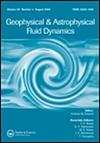深海背风波惯性振荡的共振增长
IF 1.1
4区 地球科学
Q3 ASTRONOMY & ASTROPHYSICS
Geophysical and Astrophysical Fluid Dynamics
Pub Date : 2022-11-02
DOI:10.1080/03091929.2022.2138865
引用次数: 0
摘要
在一系列典型的南大洋条件的物理参数下,讨论了惯性振荡(IO)和接近海底的背风波(LW)之间的相互作用以及IO在能量耗散中的作用。为此,将理想的垂直平面数值模拟与共振相互作用理论相结合。背风波是由均匀地转流在正弦地形上以恒定的浮力频率在中纬度发射。我们证明了IO可以通过与LW的三共振相互作用来生长。两个三和弦占主导地位,它们涉及频率为f和的波,其中为LW的固有频率,f为科里奥利频率(假设为正)。这些三元组的不同之处在于IO垂直波数的符号和值。数值模拟结果表明,选择了与IO上升相传播相关的三联征,与海洋观测相吻合,与理论预测的IO增长速率吻合较好,IO发展在1000 m以下的底层。最终达到准稳态流态,IO振幅与地转流速度在同一量级。在此期间,根据流动参数的不同,IO动能等于一个惯性周期内LW能量通量的30-70%。这个大范围的数值并没有反映在湍流动能(TKE)耗散率中,无论IO振幅如何,即使很小,耗散率也在LW能量通量的10%到30%之间。因此,对于我们考虑的参数集,TKE耗散率不能从IO振幅推断出来。然而,根据文献,背风波和IO之间的非线性相互作用对于能量谱的设置至关重要,对于低纬度的内潮和IO也是如此。这意味着在海洋混合的参数化中应考虑到IO。本文章由计算机程序翻译,如有差异,请以英文原文为准。
Resonant growth of inertial oscillations from lee waves in the deep ocean
The interactions between inertial oscillations (IO) and lee waves (LW) close to the bottom of the ocean and the role of IO in energy dissipation are addressed for a range of physical parameters typical of Southern Ocean conditions. Idealized numerical simulations in a vertical plane and resonant interaction theory are combined for this purpose. The lee waves are emitted by a uniform geostrophic flow over a sinusoidal topography for a constant buoyancy frequency at mid-latitude. We show that IO can grow by triadic resonant interactions with the LW. Two triads are dominant, which involve waves with frequency , f and , where is the intrinsic frequency of the LW and f the Coriolis frequency (assumed positive). These triads differ by the sign and value of the IO vertical wavenumber. Results from the numerical simulations show that the triad associated with the upward phase propagation of the IO is selected, consistent with oceanic observations, that a good agreement is obtained with the IO growth rate predicted theoretically and that the IO develop in a bottom layer of height less than 1000 m. A quasi-steady flow regime is eventually reached, with the IO amplitude being of the same order as the geostrophic flow speed. During this regime, depending upon the flow parameters, the IO kinetic energy is equal to 30–70% of the LW energy flux during one inertial period. This large range of values is not reflected in the turbulent kinetic energy (TKE) dissipation rate, which is comprised between 10 and 30% of the LW energy flux, whatever the IO amplitude, even if vanishingly small. Therefore, for the set of parameters we consider, the TKE dissipation rate cannot be inferred from the IO amplitude. Yet, the nonlinear interactions between the lee waves and the IO are critical in setting the energy spectrum, and similarly for the internal tide and the IO at low latitudes according to the literature. This implies that IO should be taken into account in the parameterisation of mixing in the ocean.
求助全文
通过发布文献求助,成功后即可免费获取论文全文。
去求助
来源期刊

Geophysical and Astrophysical Fluid Dynamics
地学天文-地球化学与地球物理
CiteScore
3.10
自引率
0.00%
发文量
14
审稿时长
>12 weeks
期刊介绍:
Geophysical and Astrophysical Fluid Dynamics exists for the publication of original research papers and short communications, occasional survey articles and conference reports on the fluid mechanics of the earth and planets, including oceans, atmospheres and interiors, and the fluid mechanics of the sun, stars and other astrophysical objects.
In addition, their magnetohydrodynamic behaviours are investigated. Experimental, theoretical and numerical studies of rotating, stratified and convecting fluids of general interest to geophysicists and astrophysicists appear. Properly interpreted observational results are also published.
 求助内容:
求助内容: 应助结果提醒方式:
应助结果提醒方式:


